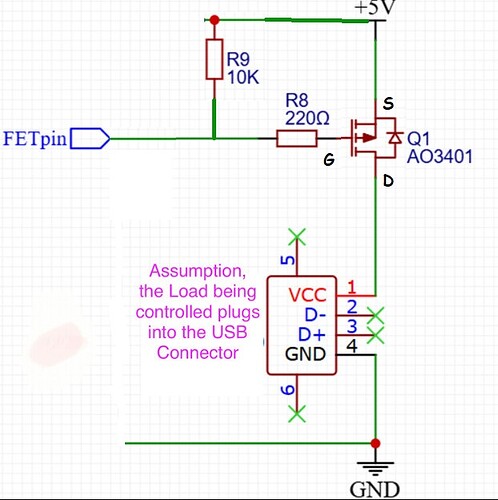I'd like to control a USB smartphone charger electronically. I've found a schematic from an old thread, but it uses a MOSFET in an SMD package. Is there any equivalent MOSFET with a low RDS(on) - about 50 milliohms - in a "bigger" package (I don't know how to say it better)? Thank you.
A through hole part is what you want.
Here is one:
Here is another but the pin spacing is not 0.1"
FYI:
That schematic is wrong.
Q1 upside down for a start.
10K should be to +5V.
Is the MOSFET logic level?
Tom.... ![]()
![]()
![]()
![]()
@TomGeorge, thank you very much for fixing the schematic! I assumed that the schematic was correct because there were no further replies (and I hadn't noticed that the last reply fixed the orientation of Q1).
Do you think that I could drive FETpin with an output pin of an Arduino board powered by the same 5 Vdc? Actually, I'd power everything with the same smartphone charger whose output the circuit is controlling.
It's not clear what you want to do so that schematic may also be wrong.
Please explain how you want to control this charger?
Which Arduino are you using?
I'd like to control the power supply to a smartphone charger using an Arduino, so I can avoid plugging and unplugging the charger. For prototyping, I'll be using an UNO R3, but I plan to switch to a Nano in the final build to keep things compact.
Do you mean the AC mains voltage input to the charger?
Oh, no! Not the AC mains voltage, but the USB end. Actually, I don't know if switching on and off the Vcc pin of the USB end will work, as smartphone chargers might be smart devices that interact with the phone instead of just providing a voltage/current source.
Is it USB-C connector?
Yes, it's USB-C. Before settling on a MOSFET-based solution, I looked into using one of the dedicated ICs designed for this type of power control. However, all the suitable ICs I found were SMD.
Forget it.
If it was just a plain old 5V power adapter, then switching the VUSB voltage will work,
If it's some kind of "smart" charger then it probably won't work since they also use the data signals and just switching VUSB will cause problems.
With USB-C it even more complicated.
Wait a second! The USB-C end connects to the phone, but the other end of the cable is USB-A, which I could wire instead. Still, as you pointed out, simply cutting the voltage won’t do the trick, so it’s clear I’d better use a dedicated IC for the job. Now that I think about it, if soldering the SMD IC proves too tricky, I could always outsource it to a professional electronics lab. Thanks again for your help!
You have a charger that is powered by USB?
In that case, it might work.
To be sure, use a USB-A charge only cable and if the charger still work correctly with that cable then cutting the VUSB 5V will work.
The charge only cables don't have the data lines.

